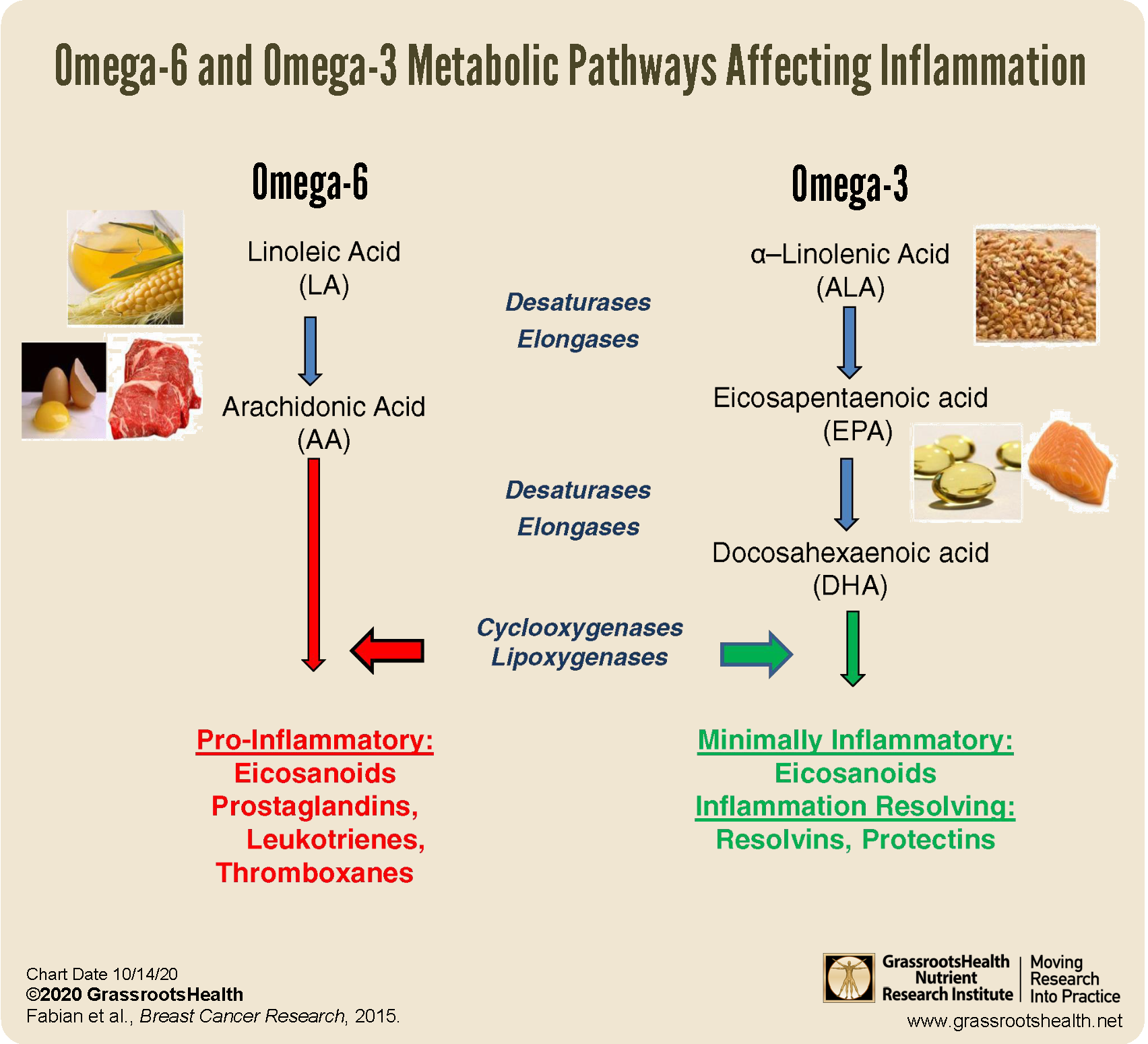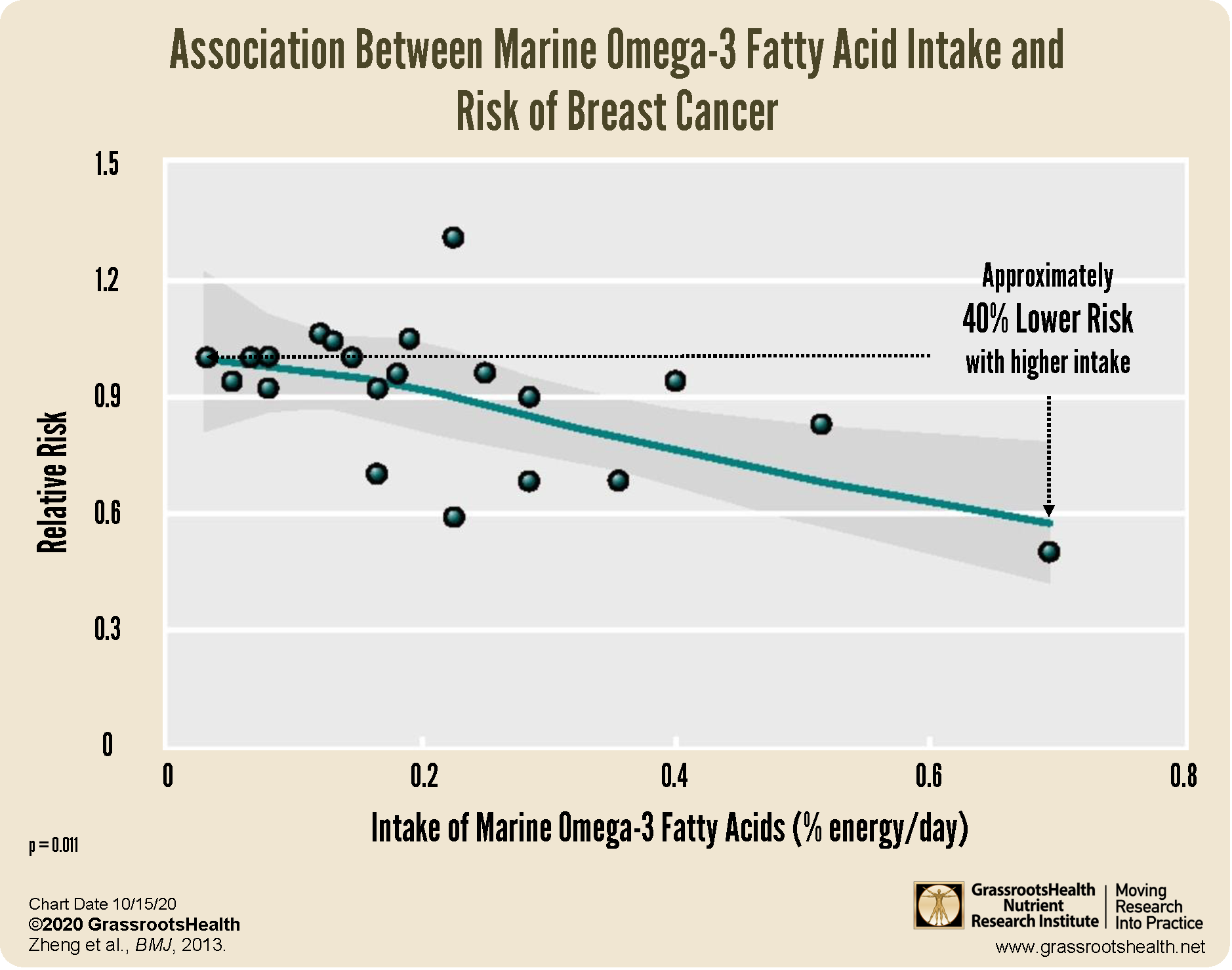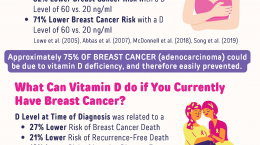Published on October 21, 2020
Reducing inflammation with omega-3s may help prevent breast cancer
 This October for Breast Cancer Prevention Month, GrassrootsHealth has focused on the importance of nutrient intake and levels for overall cancer prevention and survival. Many studies have supported the role of vitamin D in breast cancer prevention and outcomes, with some of our latest posts revisiting the importance of having vitamin D levels of at least 60 ng/ml (150 nmol/L) for breast cancer prevention. Today we will focus on omega-3 fatty acid intake and how it may affect breast cancer.
This October for Breast Cancer Prevention Month, GrassrootsHealth has focused on the importance of nutrient intake and levels for overall cancer prevention and survival. Many studies have supported the role of vitamin D in breast cancer prevention and outcomes, with some of our latest posts revisiting the importance of having vitamin D levels of at least 60 ng/ml (150 nmol/L) for breast cancer prevention. Today we will focus on omega-3 fatty acid intake and how it may affect breast cancer.
The Connection Between Inflammation, Breast Cancer, and Omega-3s
Chronic inflammation is a key contributor to the development of many chronic diseases and conditions, including cardiovascular disease, diabetes, and cancer. Several studies have also found increased levels of pro-inflammatory activity among breast cancer cells. Inflammation promotes an environment in which cancer can develop and grow and is recognized as one of the drivers. Increasing anti-inflammatory dietary factors are a potential method for mitigating inflammation and reducing the risk of cancer development and progression.
Omega-3 fatty acids are well known to provide healthful benefits for the heart, reduce inflammation, and reduce the risk of death. How does this relate specifically to breast cancer?
A review by Fabian et al. answers this exact question and provides a simple breakdown of the roles of omega-3 fatty acids and omega-6 fatty acids in the inflammatory process.
While both omega-3s and omega-6s are important for cell membrane structure, fluidity, and cell signaling, each plays a different role in inflammation, as illustrated in the diagram above. Omega-6s (such as arachidonic acid or AA) are essential for initiating and sustaining the inflammatory response – a physiologic function necessary for healing from injuries and infection. Omega-3s (such as DHA and EPA) are anti-inflammatory and promote the resolution of the inflammatory process. Unfortunately, a majority of the population consumes too many omega-6s and too few omega-3s, which can lead to an imbalance of the inflammatory response and contribute to chronic inflammation.
So how might increasing omega-3s prevent breast cancer? Reducing inflammation reduces the positive feedback it has on cancer development and progression. Counteracting the influence of pro-inflammatory omega-6s and their production of inflammatory signals (eicosanoids, prostaglandins, leukotrienes and thromboxanes) can be achieved through increasing omega-3s and the production of anti-inflammatory signals (resolvins and protectins), reducing inflammation. Further, it is thought that increasing omega-3s in the cell membrane may help disrupt the signals, called an oncogenic protein, that lead to cancer development.
Research Supports the Connection Between EPA, DHA, and Breast Cancer Prevention
A meta-analysis of 21 studies on omega-3s and risk of breast cancer by Zheng et al. concludes that higher consumption of omega-3s corresponds with a lower risk of breast cancer. The figure below shows that as dose of omega-3s (shown as % energy intake per day) increases the relative risk of breast cancer decreases (p=0.011).
Study Recommends Managing Inflammation Through Balancing Omega Fatty Acids
According to Fabian et al., the average intake of omega-3 fatty acids EPA and DHA is approximately 100 mg/day (from fish or supplements), and the average intake of omega-6 fatty acid AA is around 250 mg/day (from foods such as eggs, meat, and poultry). In order to have a better balance of pro-inflammatory AA to anti-inflammatory EPA + DHA within the tissues and cells of our bodies, the authors estimate an intake of about 2,000 – 3,000 mg/day of EPA + DHA would be needed in order to reach an omega-6:omega-3 ratio that would result in lower levels of inflammation.
GrassrootsHealth scientists recommend an Omega-3 Index of 8% or higher, which may be more equivalent to an AA:EPA ratio of around 9 or less. A GrassrootsHealth analysis found that ~1,300 mg/day of EPA+DHA was needed for 50% of the population and ~1,900 mg/day was needed for 90% of the population to achieve and Omega-3 Index of 8%. To reach an AA:EPA ratio closer to 2 or 3 would likely require achieving a higher Omega-3 Index and a higher daily dose of omega-3s and lower intake of omega-6s.
Know Your Omega-3 Status
GrassrootsHealth offers several testing options to help measure the status of omega-3 and omega-6 fatty acids – the Omega-3 Index, AA:EPA Ratio, and Omega-6:Omega-3 Ratio. Learn more about these tests and the differences between them here. More information on how to improve these test results can be found here.
What is Your Level of Inflammation? Are You Getting Enough Omega-3s and Other Nutrients?
Join the Breast Cancer Prevention Study to find out! Using the GrassrootsHealth Custom Kit Builder, you can create a test kit that measures the status of nutrients important to the regulation of inflammation (such as vitamin D, omega-3s, and magnesium), as well as your CRP level. Click here to build and order your test kit today – measure your status and take the steps necessary to improve them if needed; make an impact on your health today and for your future! When you know what your levels are, you can determine next steps to take and how much supplementation may be needed if you are not at your target levels.
Concerned specifically about your immune health? See if your immune system might be needing more vitamin D and other immune boosting nutrients by enrolling in the Immune Boost Project with the Full Immune Boost Panel (which includes tests for vitamin D, Omega-3 Index, magnesium, zinc, selenium, copper, and hsCRP).
What Does it Take YOU to Get Your D to 40 ng/ml (100 nmol/L)?
Did you know your health could be greatly affected by making sure you have a vitamin D level of at least 40 ng/ml (100 nmol/L)? Help us help you.
STEP 1 – Do you know what your vitamin D level is? If not, be sure to test today to find out.
STEP 2 – Determine your target level. Are you at your target level? Experts recommend a level of at least 40-60 ng/ml (100-150 nmol/L).
STEP 3 – Need to boost your level? Use the D*calculator to see how much vitamin D it may take to reach your target. Opt for the Loading Dose for a quicker boost.
STEP 4 – Optimize how your body absorbs and utilizes vitamin D with co-nutrients and these simple steps.
STEP 5 – Re-Test! This is an important step to make sure you have reached your target level, and to ensure you are not taking too much! Re-testing after 3-4 months is recommended.
STEP 6 – Adjust, Repeat…
Through GrassrootsHealth Nutrient Research Institute, you can also test your essential elements magnesium, copper, zinc and selenium, toxins such as lead, mercury and cadmium, as well as your omega-3 levels, inflammation levels and thyroid stimulating hormone (TSH) level. Find out your levels today! Log on to the test selection page (click the link below) to get your tests and see for yourself if your levels can be improved.
Make sure you track your results before and after, about every 6 months!
How can I track my nutrient intake and levels over time?
To help you track your supplement use and nutrient levels, GrassrootsHealth has created the Personal Health Nutrient Decision System called
For each specific supplement, you can track what days you take it, how much, and many other details. This will help you know your true supplemental intake and what patterns of use work for you to reach and maintain optimum nutrient levels. Check it out today!










